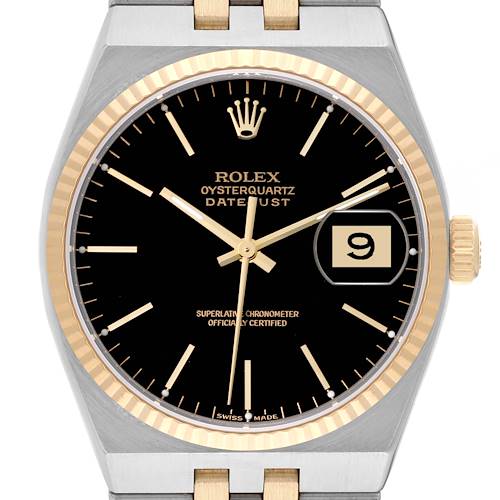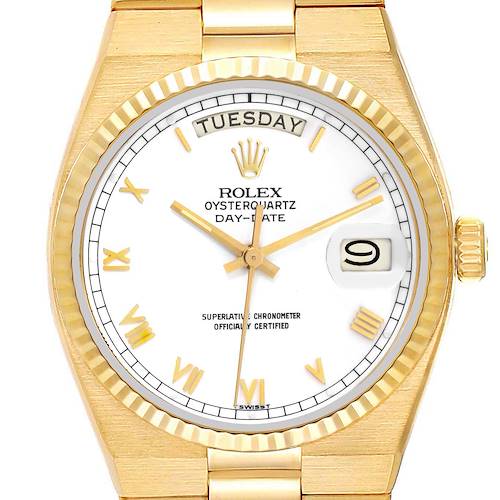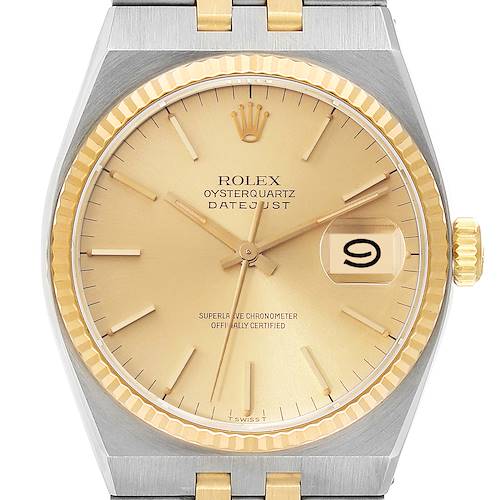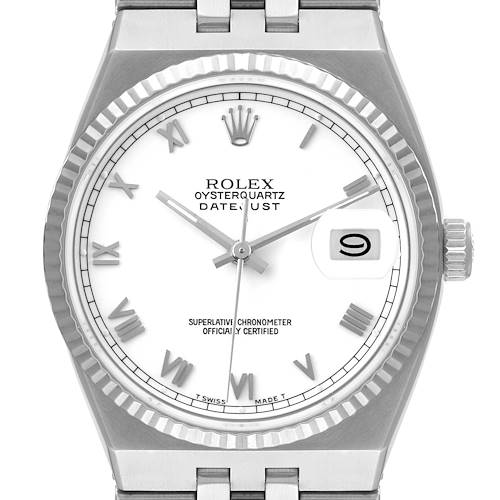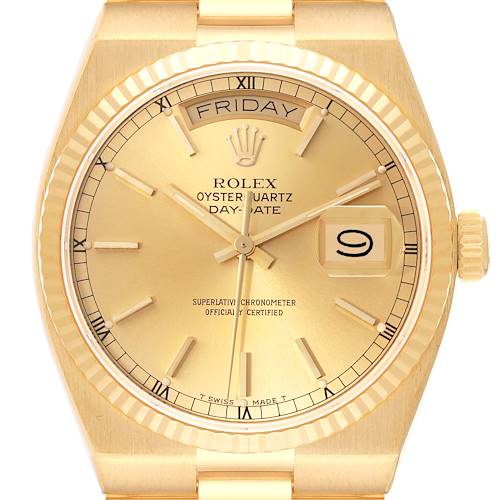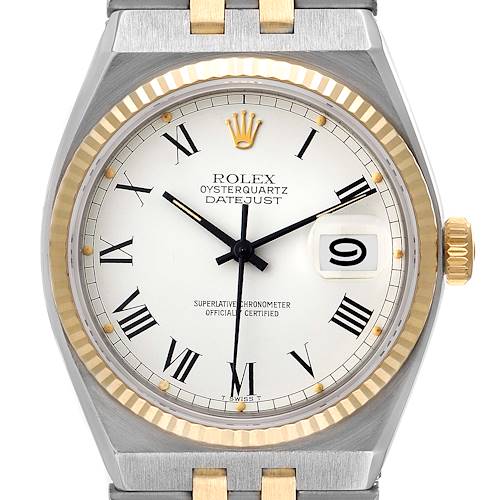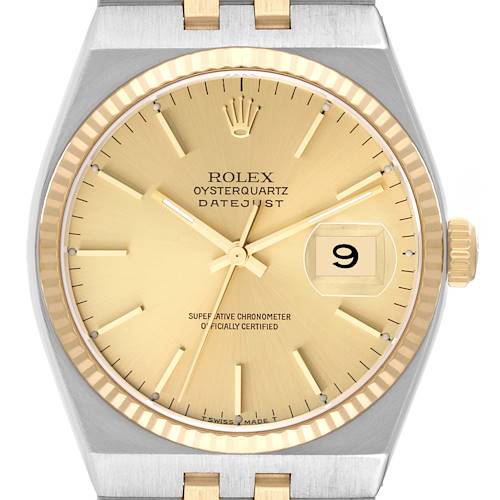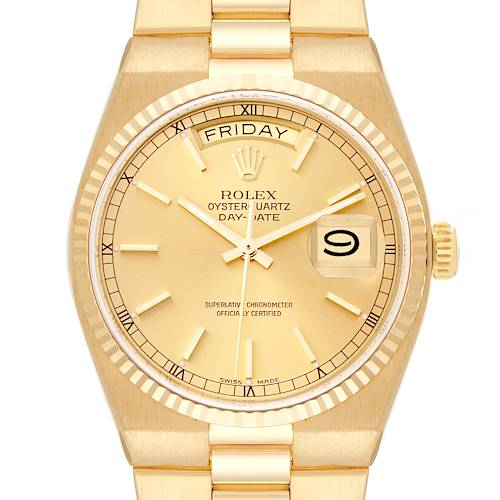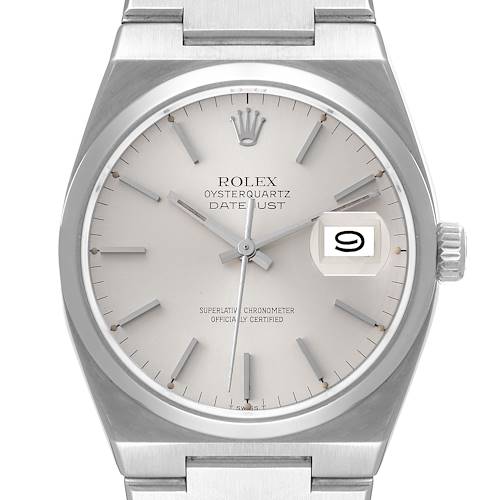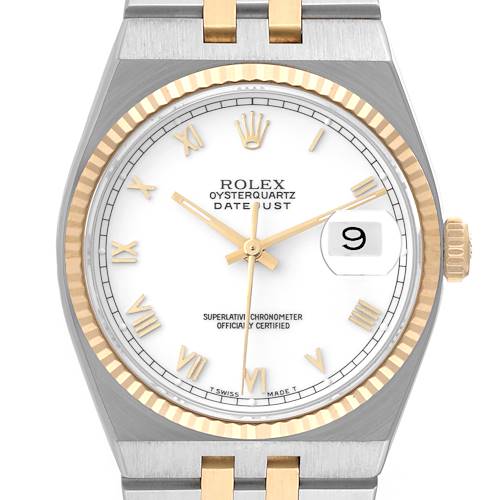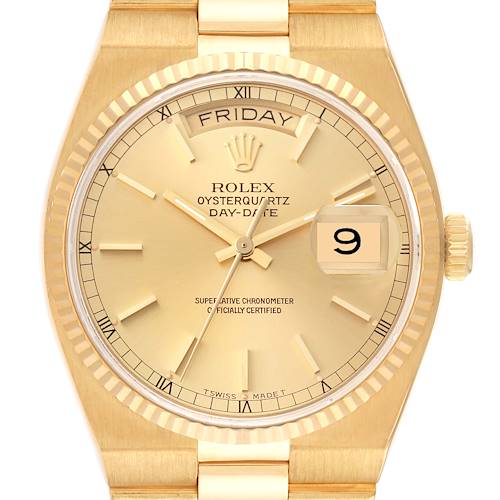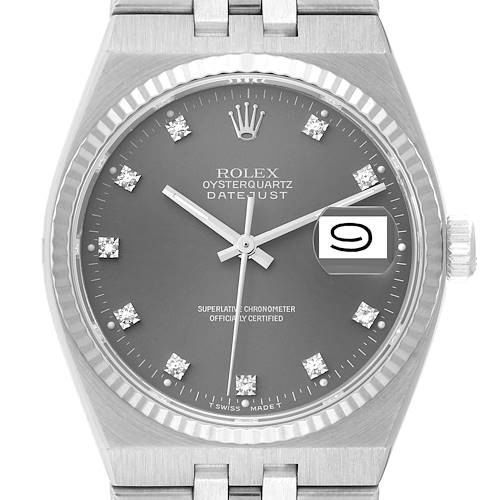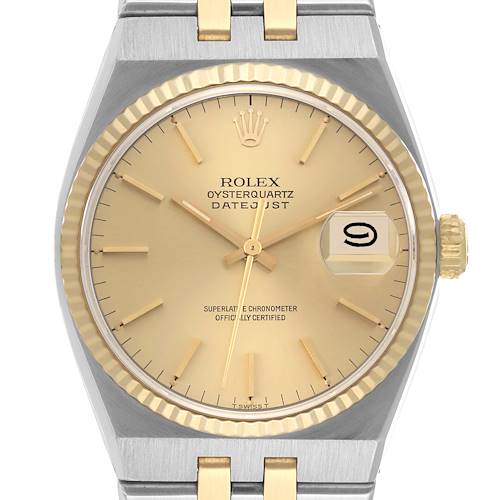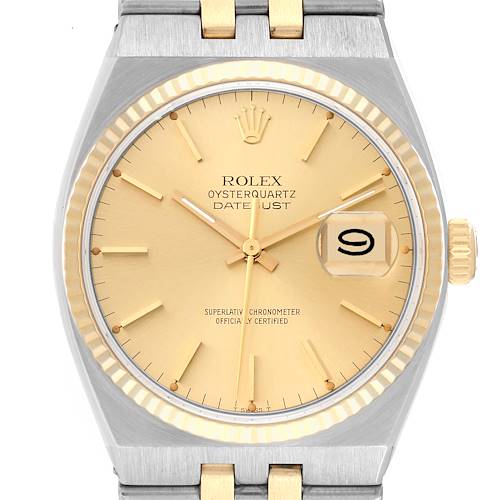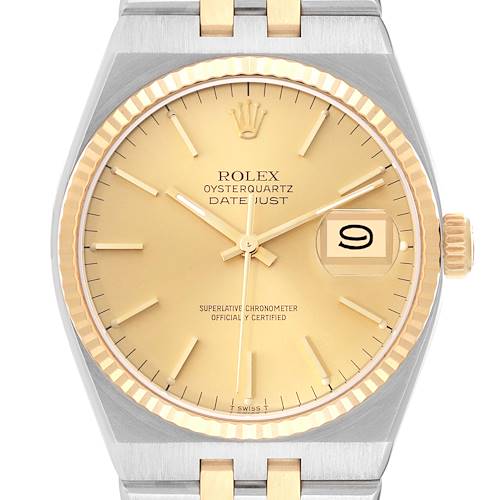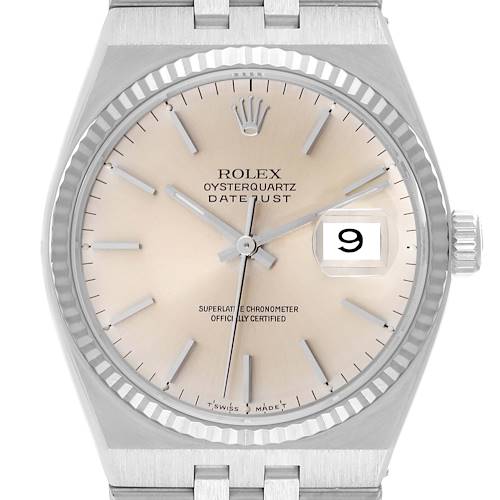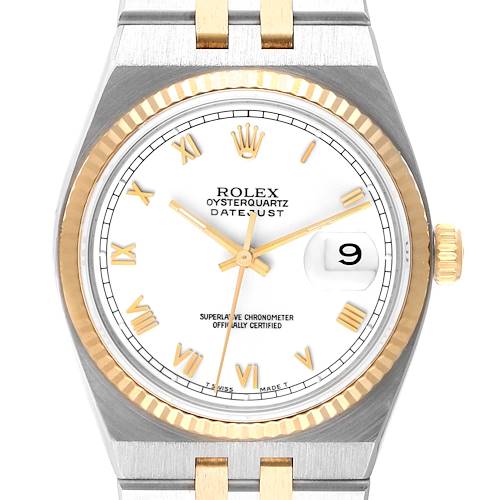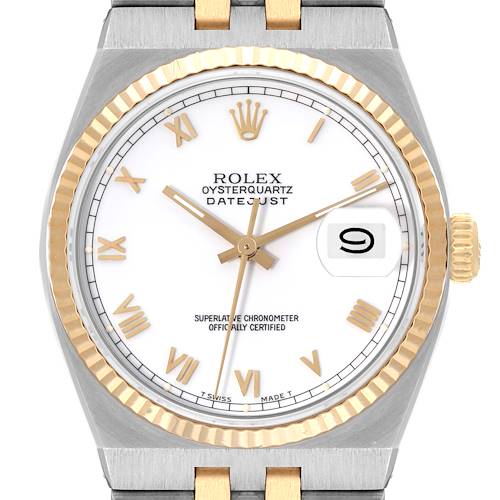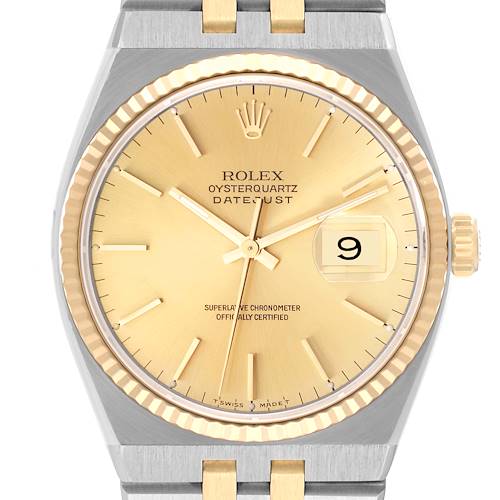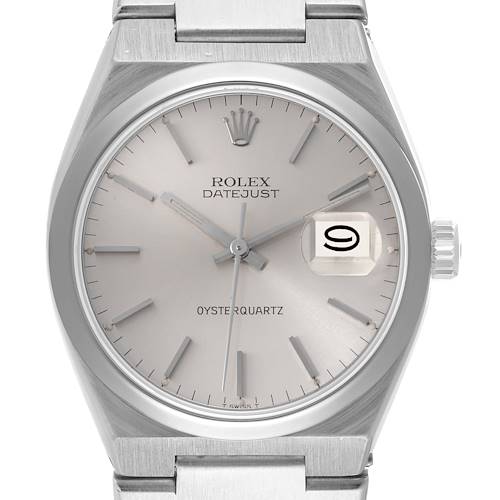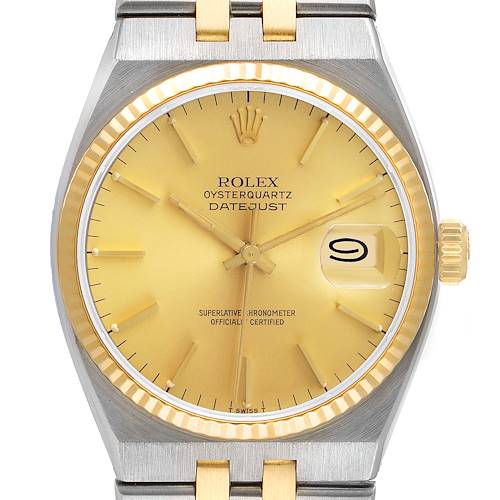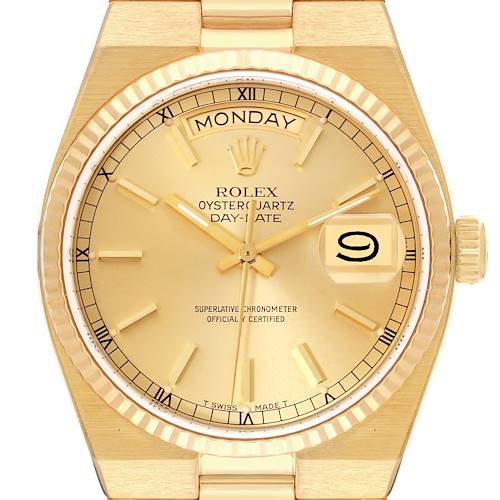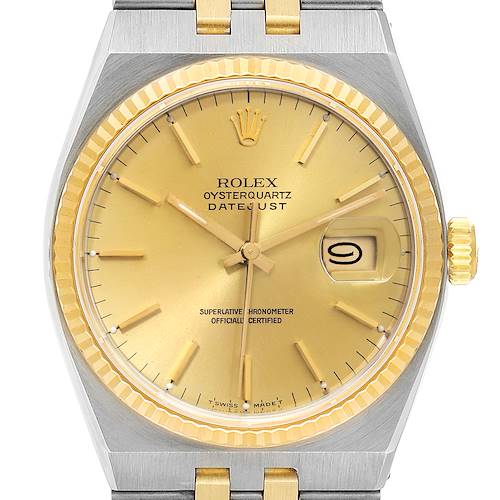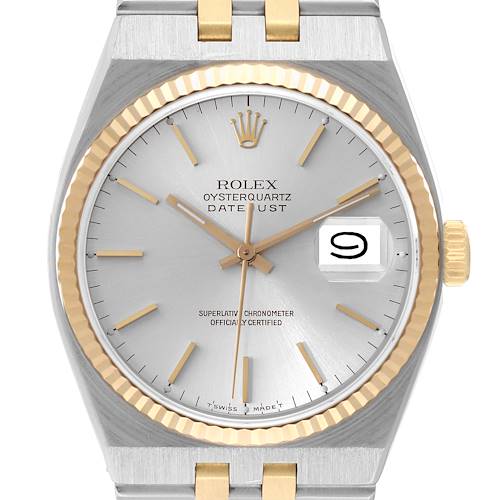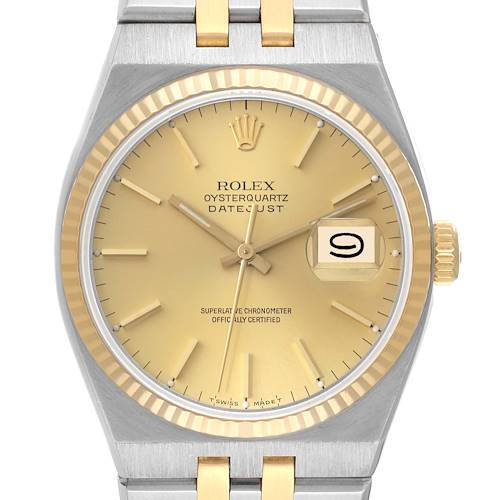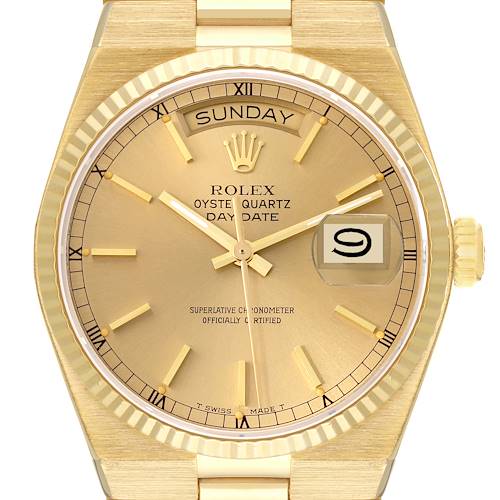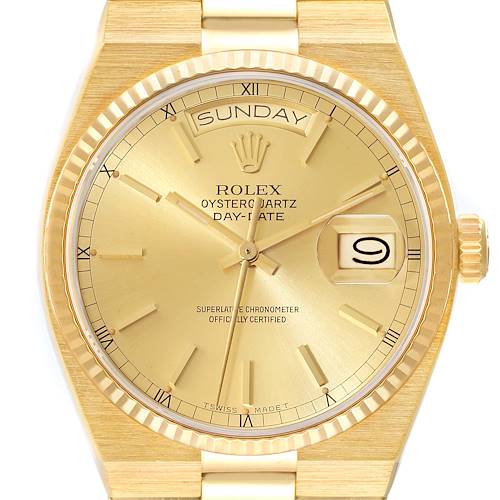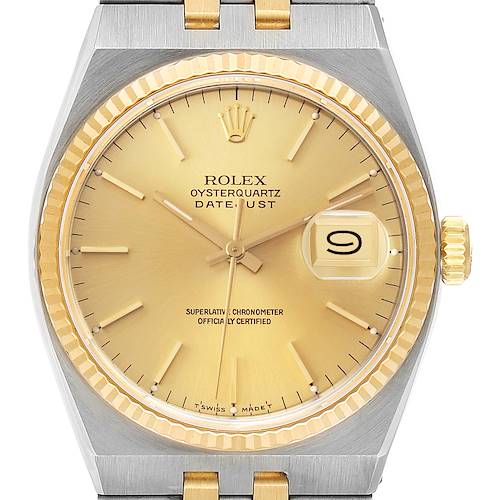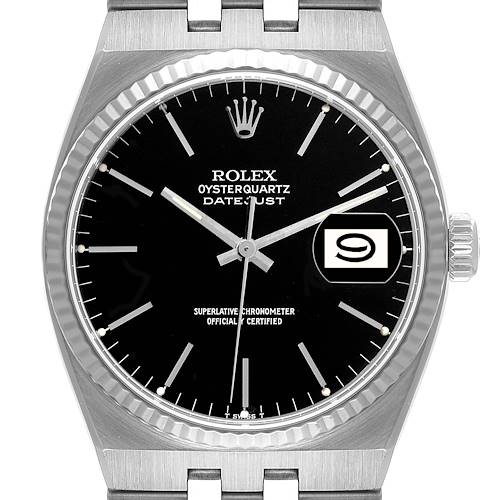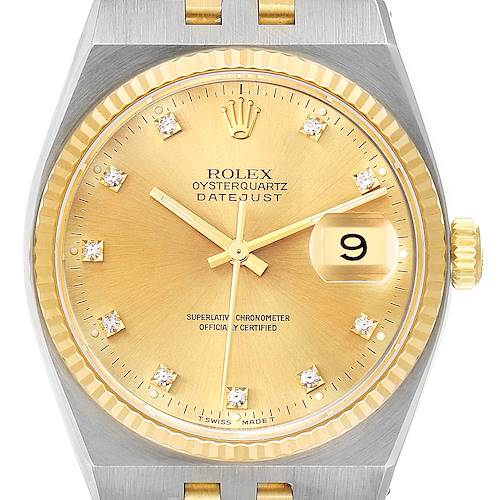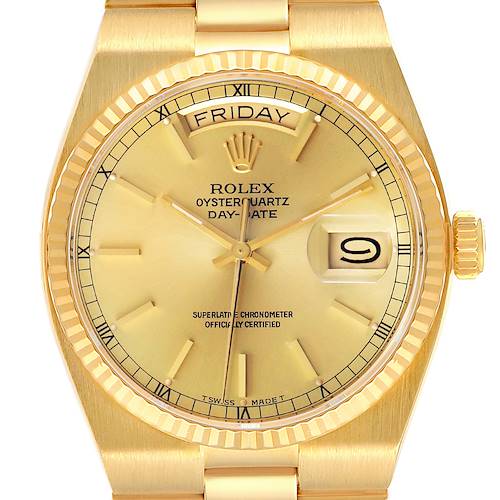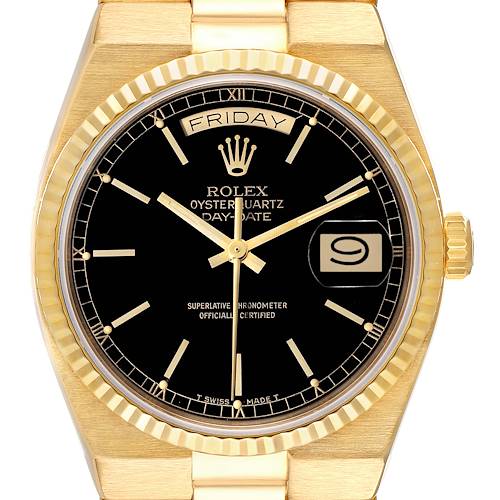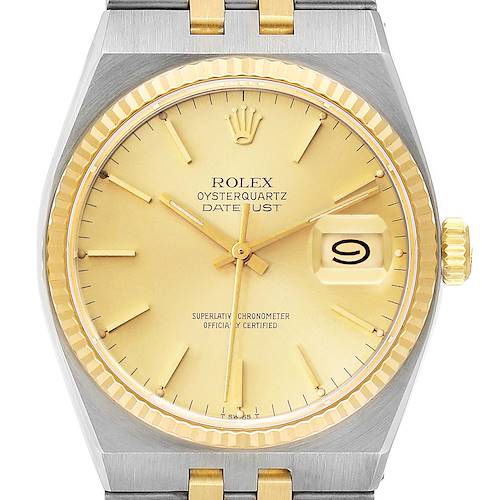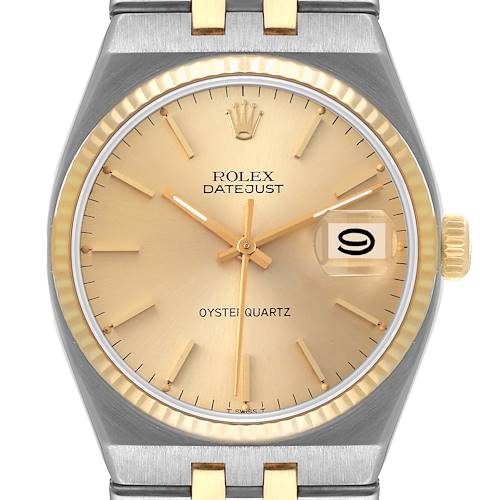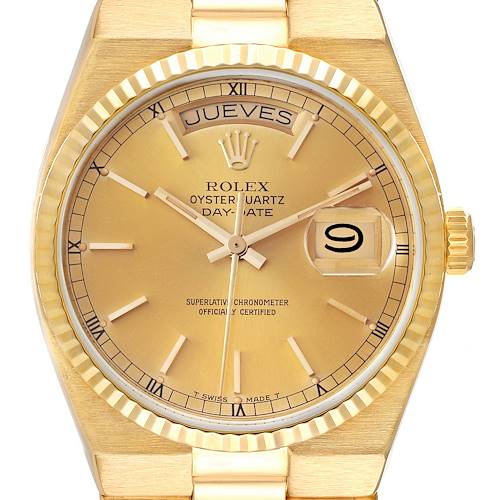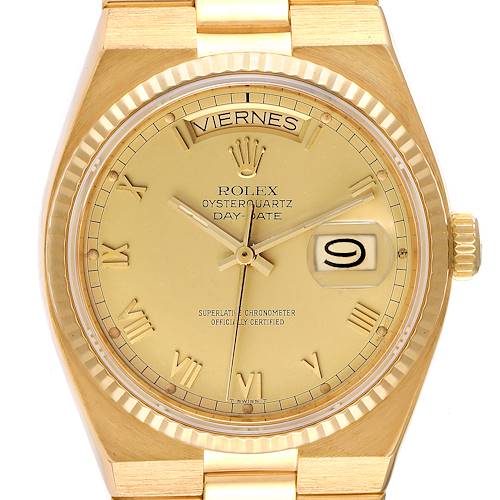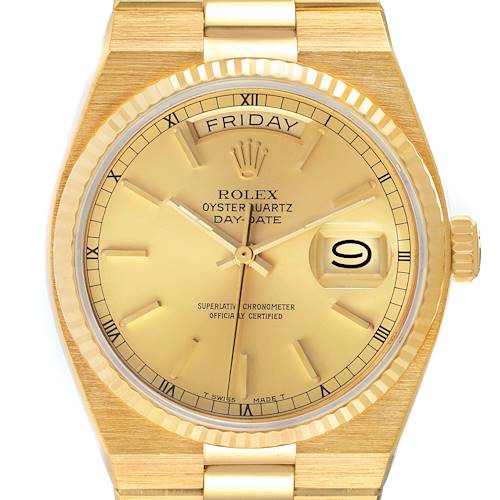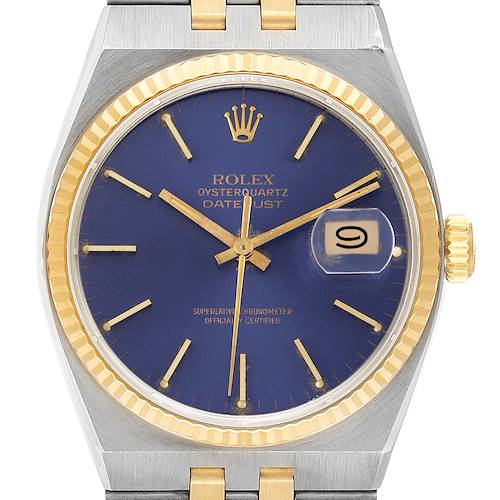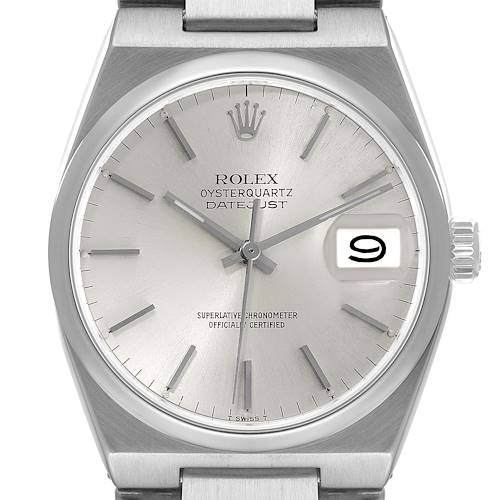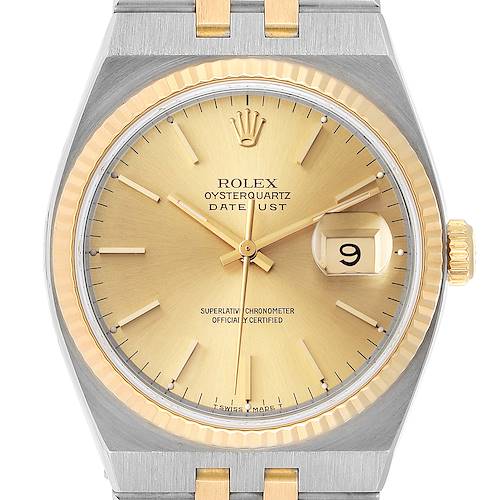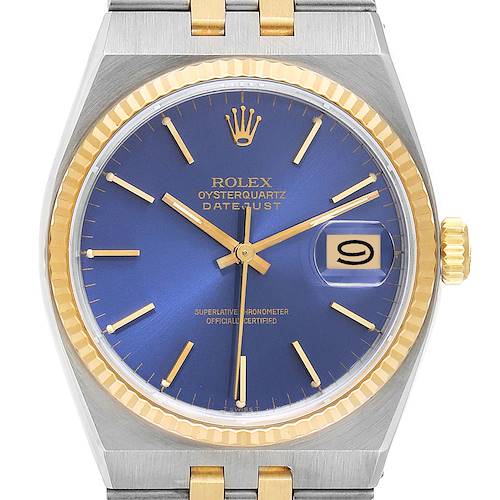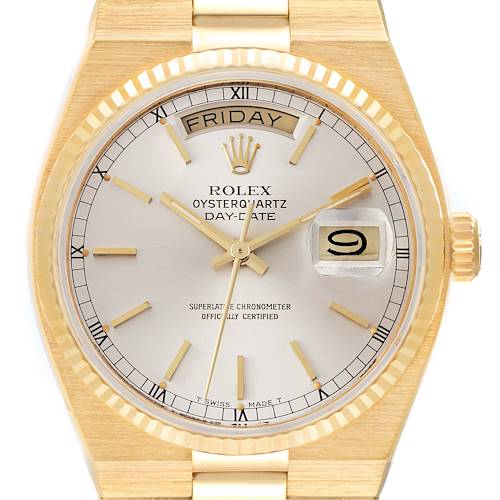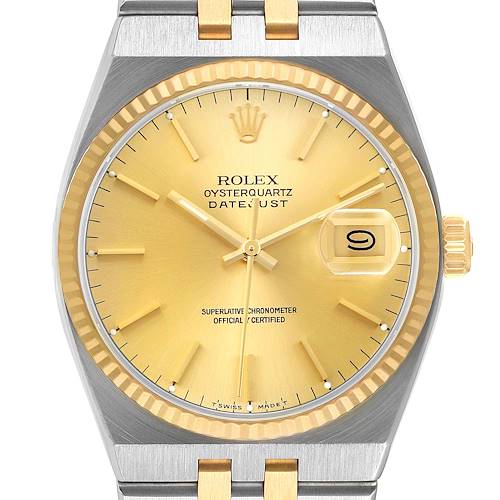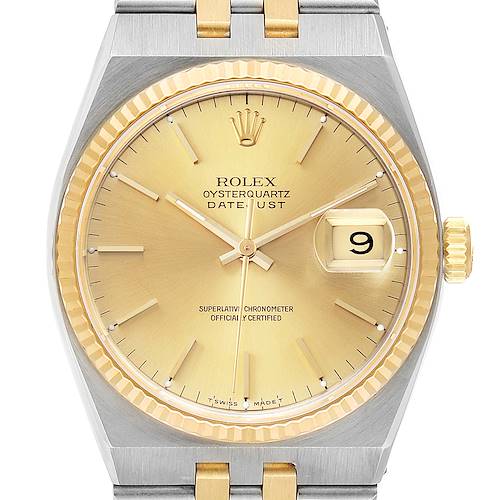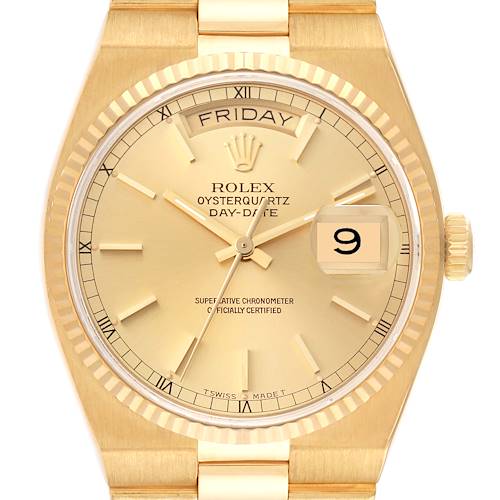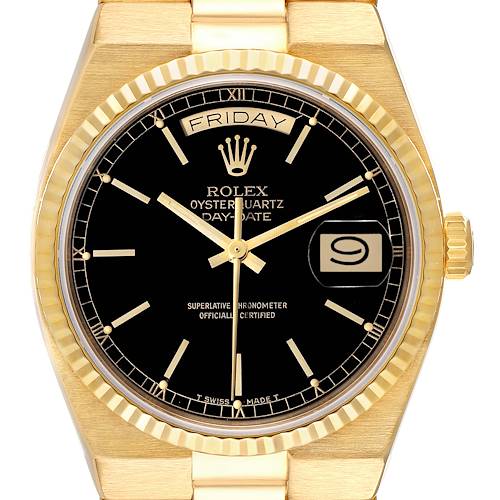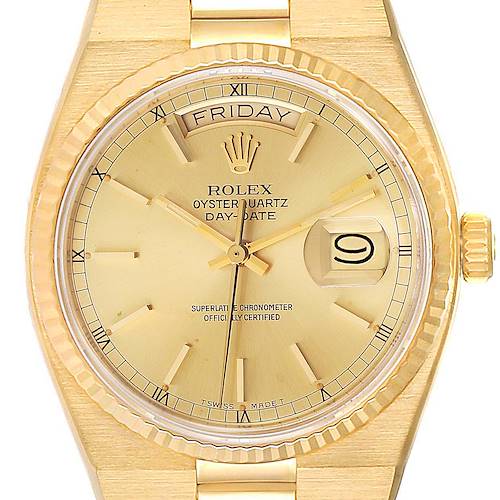- CALL US (404) 814-1814
- LIVE SUPPORT
- EMAIL US
-
WISHLIST (0)
-
CART(0)
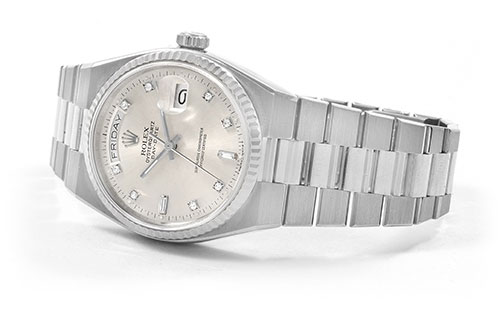
Men's Oysterquartz | Rolex Watch Collection
225 MATCHES FOUND
IN STOCK
SwissWatchExpo ARCHIVE - RECENTLY SOLD
Rolex Oysterquartz Collection
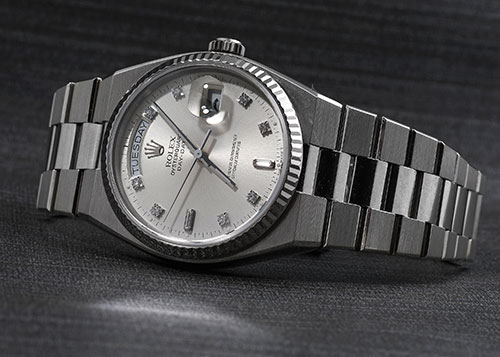
Rolex is world renowned for its precise, reliable, and rigorously certified mechanical movements, but at one point in time, The Crown also made quartz timepieces – namely the Rolex Oysterquartz.
The “Quartz Crisis” of the 1970s posed a challenge to the entire watchmaking industry, with the introduction of less expensive yet more precise quartz watches. Rolex joined other watch brands in a leap to develop this then futuristic watch movement, until Rolex left the consortium to develop not just a quartz caliber, but an entire collection of quartz timepieces.
With an angular tonneau case and integrated bracelet, the Rolex Oysterquartz was given look that was very modern at the time, and one that stood out from the rest of the catalog. The Rolex Oysterquartz would over time also become a venue for experimentation for Rolex, with a wide range of dial designs and metal combinations offered. Surely, Rolex made the case that quartz watches could be just as high-quality and luxurious as mechanical timepieces.
While the Rolex Oysterquartz has long been discontinued, it showed Rolex’s ability to adapt to global developments, and put their own spin to new technologies. It continues to be sought after among watch collectors because of its bold aesthetic, one of a kind movement, and its place in watchmaking history.
Explore our collection of Rolex Oysterquartz watches at SwissWatchExpo.com.
A BRIEF HISTORY OF THE ROLEX OYSTERQUARTZ
As Japanese and American suppliers saturated the global market with quartz watches in the 1970s, several high-profile Swiss watchmakers banded together and produced their own take on quartz watchmaking. To remain competitive in this new era of horology, they formed the Centre Electronique Horloger (CEH), whose primary mission was to form a quartz movement that could rival the competition.
This consortium eventually came up with the Beta 21 movement, which paved the way for Rolex’s first quartz watch – the prototype ref 5100 Beta 21. While the watch became commercially successful, it presented a few hiccups. First, the movement was too large to fit inside Rolex’s trademark Oyster case. Second, being a product of the consortium, it was also being used by Rolex’s direct rivals.
Rolex formally withdrew from CEH and began working on their own quartz movement. In 1977, after 5 years of development and testing, Rolex introduced their very own collection of quartz watches – the Oysterquartz.
The watches were powered by two new movements, Calibers 5035 (date) and 5055 (day and date). With 11 jewels and a 32khz oscillator, the new in-house quartz movements became a standard in the industry.
Not only did the Oysterquartz present a new movement, with it came an unorthodox design that stood out from other Rolex watches. The watches had thick and angular tonneau cases, and bracelets integrated into the case – an aesthetic that was very much on-trend in the 1970s. Moreover, they were incorporated into two of Rolex’s most iconic models – the Datejust and the Day-Date. These formed the two families of watches: the Oysterquartz Datejust and the Oysterquartz Day-Date.
The simpler Oysterquartz Datejust was offered in steel, yellow gold, and Rolesor models, with simple dials and a choice of Oyster or Jubilee bracelets. With the Oysterquartz Day-Date, Rolex kept it exclusive to yellow gold and white gold, but experimented with a wide range of dial materials and designs (such as wood and tapestry). Some models were also embellished with diamonds, rubies, and sapphires.
Although Rolex continued to produce the Oysterquartz well until 2003, only about 25,000 pieces were made in its lifetime – a very low number in Rolex manufacturing. This makes it a less common Rolex model. Its rarity, together with its unique design and place in watchmaking history, make it one that continues to be sought after among collectors today.
ABOUT THE ROLEX OYSTERQUARTZ COLLECTION
Rolex produced the Oysterquartz collection from 1977 until the early 2000s. Its distinctive movement called for a look that is just as different to distinguish it from the rest of the Rolex catalog. With an angular shape and integrated bracelets, the Rolex Oysterquartz’s aesthetic was very on-trend in the seventies.
Rolex made an assortment of Oysterquartz models, divided into two families: the Oysterquartz Datejust and the Oysterquartz Day-Date.
Rolex Oysterquartz Datejust
Reference numbers: 17000, 17013, 17014
The Rolex Oysterquartz Datejust is the simple three-hand version with a date aperture. It was made available in three models – stainless steel, yellow gold, and two-tone steel and gold. Dial colors ranged from champagne, silver, black, and the more rare purple dial.
All of the models came with sober baton dials and fluted bezels, and were paired with either Oyster or Jubilee bracelets that were integrated into the case. They were powered by the Caliber 5035.
Rolex Oysterquartz Day-Date
Reference numbers: 19018, 19019, 19028, 19038, 19048, 19049, 19058, 19068, 19078, 19148, 19168, 19188
The Rolex Oysterquartz Day-Date takes after the President’s watch, with a date display at 3 o’clock and the full day of the week displayed at 12 o’clock. This collection had more designs on offer, with a wide range of dials that ranged from champagne, silver, lacquered and matte black, tapestry, burr walnut, burgundy, and many more. There were even a few references with gem-set bezels, embellished with either diamonds, rubies, or sapphires.
In line with the model family, the Oysterquartz Day-Date was equipped with a three-piece Presidential bracelet that is flatter and integrated into the case. They were powered by the Caliber 5055.
ROLEX OYSTERQUARTZ REFERENCE NUMBERS
Rolex Oysterquartz models are available with these reference numbers:
| REFERENCE NUMBER | MODEL | MATERIALS |
|---|---|---|
| 19018 | Rolex Oysterquartz Day-Date | yellow gold Oyster case, fluted bezel, and integrated Presidential bracelet |
| 19019 | Rolex Oysterquartz Day-Date | white gold Oyster case, fluted bezel, and integrated Presidential bracelet |
| 19028 | Rolex Oysterquartz Day-Date | yellow gold Oyster case, pyramid style bezel, and integrated Presidential bracelet with pyramid style center links |
| 19038 | Rolex Oysterquartz Day-Date | yellow gold Oyster case, pyramid style bezel with 12 diamonds, and integrated Presidential bracelet with pyramid style center links |
| 19048 | Rolex Oysterquartz Day-Date | yellow gold Oyster case, diamond-set bezel, and yellow gold integrated Presidential bracelet |
| 19049 | Rolex Oysterquartz Day-Date | white gold Oyster case, diamond-set bezel, and white gold integrated Presidential bracelet |
| 19058 | Rolex Oysterquartz Day-Date | yellow gold Oyster case, gem-set bezel with baguette cut diamonds, rubies, or sapphires, and yellow gold integrated Presidential bracelet |
| 19068 | Rolex Oysterquartz Day-Date | yellow gold Oyster case, diamond-set bezel, yellow gold integrated Presidential bracelet with pyramid style center links |
| 19078 | Rolex Oysterquartz Day-Date | yellow gold Oyster case, rainbow color gem-set bezel, and yellow gold integrated Presidential bracelet |
| 19148 | Rolex Oysterquartz Day-Date | yellow gold Oyster case, diamond-set bezel, and yellow gold integrated Presidential bracelet with diamond-set center links |
| 19168 | Rolex Oysterquartz Day-Date | yellow gold Oyster case, gem-set bezel with baguette cut diamonds, rubies, or sapphires, yellow gold integrated gem-set Presidential bracelet |
| 19188 | Rolex Oysterquartz Day-Date | yellow gold Oyster case, diamond and ruby-set bezel, and yellow gold integrated Presidential bracelet with diamond-set center links |
| 17000 | Rolex Oysterquartz Datejust | Stainless steel Oyster case and smooth bezel, stainless steel integrated three-piece Oyster bracelet |
| 17013 | Rolex Oysterquartz Datejust | Stainless steel Oyster case with yellow gold crown and bezel, Rolesor integrated bracelet |
| 17014 | Rolex Oysterquartz Datejust | Stainless steel Oyster case, white gold fluted bezel, stainless steel integrated five-piece Jubilee bracelet |
COMMON QUESTIONS ABOUT THE ROLEX OYSTERQUARTZ
With the Rolex Oysterquartz collection, Rolex showed that even quartz watches could be as refined as mechanical timepieces. Here are answers to the most frequently asked questions about the Rolex Oysterquartz.
WHAT IS A ROLEX OYSTERQUARTZ WATCH?
The Rolex Oysterquartz is a collection of quartz watches produced by Rolex from 1977 to the early 2000s.
During the 1970s Quartz Crisis, Japanese suppliers put forward large quantities of quartz watches, which were less expensive yet more accurate. Rolex joined a consortium of watchmakers who sought to create their own quartz movement, but they eventually left and made their own movement.
The result was the Rolex Oysterquartz, a watch that differed greatly from the Rolex line, not just because of its movement, but also because of its angular case, integrated bracelet, and sapphire crystal.
IS THE ROLEX OYSTERQUARTZ WATERPROOF?
Rolex Oysterquartz watches are water resistant to 100 meters, thanks to their three-body construction: a robust tonneau-shaped case, an inclined bezel, a screw down case back, and an Oyster crown that secures them together.
With this level of water resistance, and considering the vintage nature of the Oysterquartz, the wearer can use it for light water exposure, such as handwashing.
HOW OFTEN SHOULD A ROLEX OYSTERQUARTZ BE SERVICED?
Rolex generally recommends a service every 3-5 years. By nature, however, vintage timepieces tend to be fragile, so it's recommended to have any vintage watch serviced every two years.
However, a watch’s water resistance and accuracy are not permanent and are subject to wear and tear. There may be signs that your watch needs a service sooner rather than later. Read on for Signs It’s Time for Watch Maintenance.


